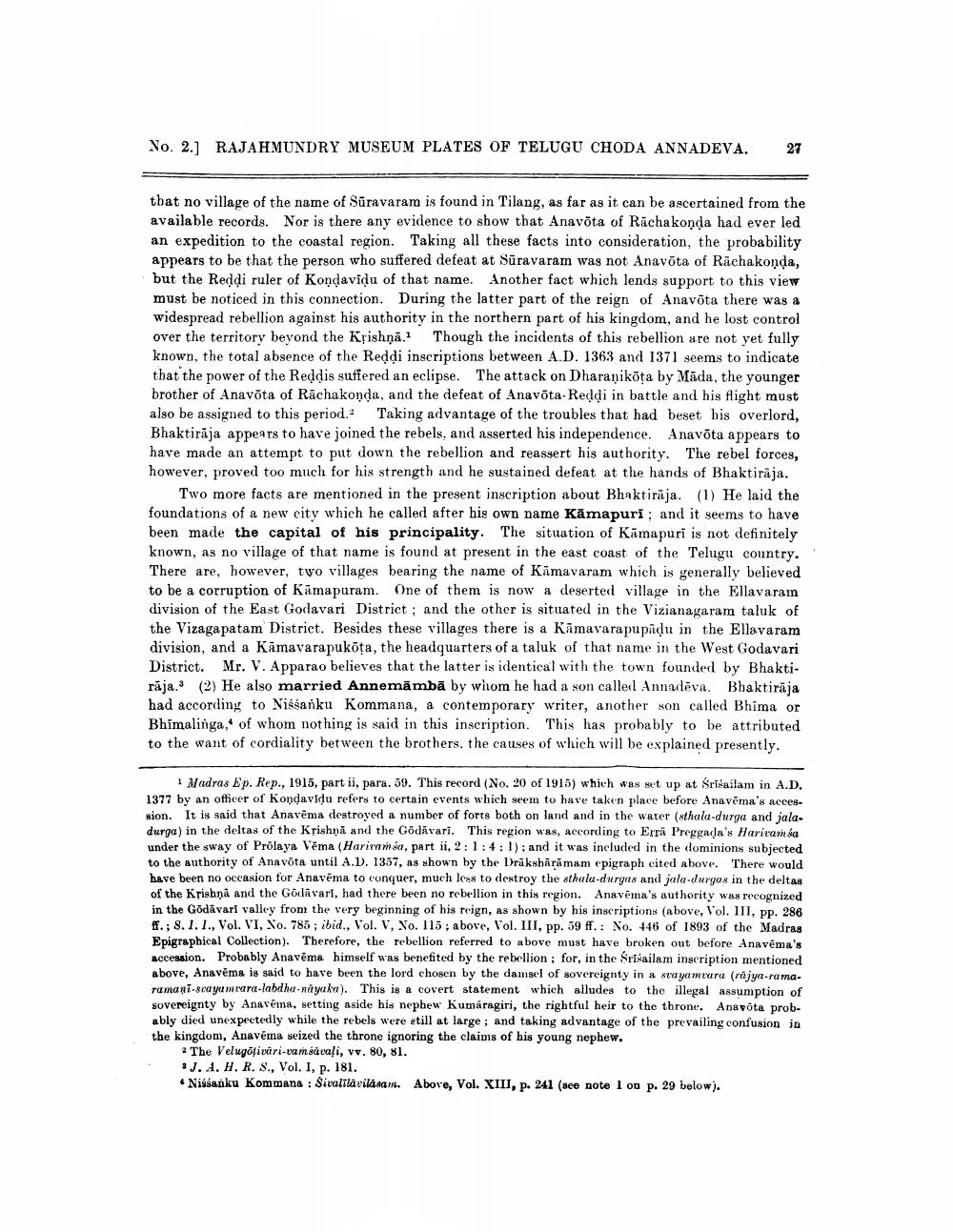________________
No. 2.) RAJAHMUNDRY MUSEUM PLATES OF TELUGU CHODA ANNADEVA.
27
that no village of the name of Süravaram is found in Tilang, as far as it can be ascertained from the available records. Nor is there any evidence to show that Anavõta of Rāchakonda had ever led an expedition to the coastal region. Taking all these facts into consideration, the probability appears to be that the person who suffered defeat at Sūravaram was not Anavõta of Rachakonda, but the Reddi ruler of Kondavidu of that name. Another fact which lends support to this view must be noticed in this connection. During the latter part of the reign of Anavõta there was a widespread rebellion against his authority in the northern part of his kingdom, and he lost control over the territory beyond the Krishņā. Though the incidents of this rebellion are not yet fully known, the total absence of the Reddi inscriptions between A.D. 1363 and 1371 seems to indicate that the power of the Reddis suffered an eclipse. The attack on Dharanikota by Māda, the younger brother of Anavõta of Rāchakonda, and the defeat of Anavõta-Reddi in battle and his flight must also be assigned to this period." Taking advantage of the troubles that had beset bis overlord, Bhaktiraja appears to have joined the rebels, and asserted his independence. Anavõta appears to have made an attempt to put down the rebellion and reassert his authority. The rebel forces, however, proved too much for his strength and he sustained defeat at the hands of Bhaktiraja.
Two more facts are mentioned in the present inscription about Bhaktiraja. (1) He laid the foundations of a new city which he called after his own name Kāmapuri; and it seems to have been made the capital of his principality. The situation of Kamapuri is not definitely known, as no village of that name is found at present in the east coast of the Telugu country. There are, however, two villages bearing the name of Kāmavaram which is generally believed to be a corruption of Kāmapuram. One of them is now a deserted village in the Ellavaram division of the East Godavari District ; and the other is situated in the Vizianagaram taluk of the Vizagapatam District. Besides these villages there is a Kamavarapupidu in the Ellavaram division, and a Kāmavarapukota, the headquarters of a taluk of that name in the West Godavari District. Mr. V. Apparao believes that the latter is identical with the town founded by Bhaktirāja. (2) He also married Annemāmbā by whom he had a son called Annadēva. Bhaktirāja had according to Nissanku Kommana, a contemporary writer, another son called Bhima or Bhimalinga, of whom nothing is said in this inscription. This has probably to be attributed to the want of cordiality between the brothers, the causes of which will be explained presently.
I Madras Ep. Rep., 1915, part ii, para. 59. This record (No. 20 of 1916) which was set up at Srisailam in A.D. 1377 by an officer of Kondavidu refers to certain events which seem to have taken place before Anavēma's accession. It is said that Anavēma destroyed a number of forts both on land and in the water (sthalu-durga and jaladurga) in the deltas of the Krishna and the Godavari. This region was, according to Eura Preggada's Haritamsa under the way of Prölaya Vema (Hariva, part ii, 2: 1:4:1); and it was included in the dominions subjected to the authority of Anavõta until A.D. 1357, as shown by the Dräksharamam epigraph cited above. There would have been no occasion for Anavema to conquer, much less to destroy the sthalu-durgas and jula-duryas in the deltas of the Krishna and the Godavari, had there been no rebellion in this region. Anavema's authority was recognized in the Godavari valley from the very beginning of his reign, as shown by his inscriptions (above, Vol. 111, pp. 286 ff. ; 8.1.1., Vol. VI, Xo. 785 ; ibid., Vol. V, No. 115 ; above, Vol. III, pp. 59 ff. : No. 446 of 1893 of the Madras Epigraphical Collection). Therefore, the rebellion referred to above must have broken out before Anavema's accession. Probably Anavēma himself was benefited by the rebellion : for, in the Srisailam inscription mentioned above, Anavēma is said to have been the lord chosen by the damsel of sovereignty in a svayamvuru (rajya-rama. ramani-swayamvara-labdhanayake). This is a covert statement which alludes to the illegal assumption of sovereignty by Anasema, setting aside his nephew Kumāragiri, the rightful heir to the throne. Anavota probably died unexpectedly while the rebels were etill at large; and taking advantage of the prevailing confusion in the kingdom, Anavema seized the throne ignoring the claims of his young nephew.
2 The Velugõivari-carsavali, vv. 80, 81. 3J. 4. H.R. S., Vol. I, p. 181. • Nissanku Kommana : Sivalila vilasan. Above, Vol. XIII, p. 241 (see note 100 p. 29 below).




